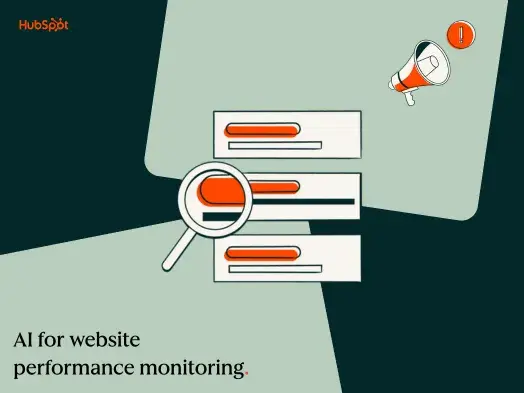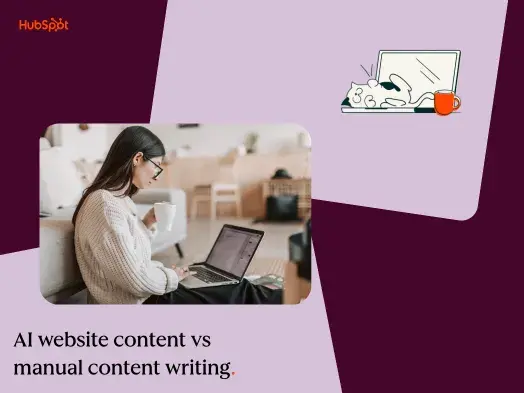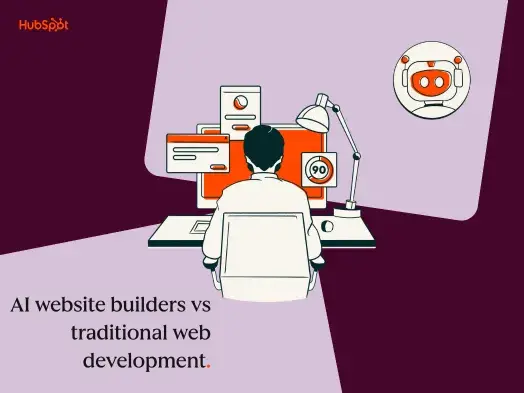We chatted with Jennifer Lux, HubSpot’s Head of Growth Acquisition, to help you learn how to use AI for stronger websites. To begin, we’ll define what constitutes a “high-performing” site. Then, we’ll dive into how Lux suggests you can use AI to support the creation of such sites. Finally, we’ll share some of our favorite tools if you want to use AI for stronger websites.
-
How can AI support the creation of a ‘high-performing’ website?
-
What are the tools you can use to harness the power of AI for stronger websites?
How do we define a high-performing website?
According to Lux, a common misconception about high-performing websites is that your site can only be described as such if it drives a ton of traffic or ranks for many keywords.
“While many people might think that high-performing sites are ones that drive a high volume of traffic or rank for many keywords, true [high] performance sites are those that drive quality traffic aligned with the company’s target audience, buyer, and/or core market,” shares Lux. Therefore, even if your site isn’t garnering a million visits a month, it’s not necessarily a bad thing. If your site is bringing in less traffic, but they’re more qualified leads, then your site is high-performing.
Instead, Lux suggests that you take a more KPI-oriented approach to determine what a high-performing website would look like in your individual circumstance. “Some key performance indicators to keep in mind when measuring site performance are conversion rate for each website property (blog, webpages, offer pages, etc), time on page, number of pages per session, visitor-to-lead ratio, visitor-to-signup ratio (for software), and more,” she shares.
Ultimately, high-performing websites don’t stray from their mission, which is to delight visitors. “High-performing sites truly serve their potential customers,” shares Lux. “They help visitors solve their top challenges and provide a product or service that helps them do their jobs better (or ‘improves their quality of life’ if speaking to both a B2B and B2C audience).”
Now that you know how to define a high-performing website, let’s dive into how to use artificial intelligence to bolster creating your own.
How can AI support the creation of a ‘high-performing’ website?
So, how can you use AI for stronger websites? There are five main ways you can use AI to build a high-performing website. Here are Lux’s top suggestions for how to do so. Let’s dive in.
AI can help you create more relevant content faster.
If you’re a startup or you’re creating a website on a budget, you might be looking for any way you can possibly can to reduce the amount of time to get your site up and running. Additionally, you may be looking to do so as cost-effectively as possible. Don’t get us wrong — you’ll need writers and editors, especially if you’re looking to create a blog. However, if you need to get content created quickly to get your blog started on the right note, you can use generative AI to help you begin. That way, you have a basis of content to start with.
“AI-powered content tools can help a business accelerate the volume of relevant content they have available to their audience in the form of blogs, offers, general webpages, and other informational content on their websites,” says Lux.
Another way that you can use AI to start your high-performing website on the right foot? By using generative AI to create engaging, on-brand imagery. Remember: Make sure the imagery (and the copy!) you create using AI-powered tools will appeal to your target audience. After all, that’s what differentiates a high-performing site from a lackluster one.
AI can help you personalize your website.
Another strength of AI? You can use it to help make your website more personalized. Again, this contributes to a more delightful site for your visitors — a frustration-free experience that will have visitors returning again and again.
“AI could conceptually provide a unique and curated website experience for each and every visitor based on those visitors’ unique preferences, needs, and interests,” says Lux. “Leveraging AI in this way truly unlocks personalized marketing at scale, which is the grand prize for so many marketers striving to create relevant and meaningful connections with their target audience.”
AI can help you edit your site content to ensure it lands correctly with your audience.
Have you ever written a paragraph that’s good but not great? Whether it’s not landing exactly as you’d like or not matching your brand’s tone perfectly, you can use AI to fix it up. “AI can also improve the tone of content on sites, making it more engaging for the reader, [which] positively impacts important KPIs like visitor-to-lead ratio and number of pages per session,” says Lux.
AI can give you suggestions you might not have considered.
According to Lux, another strength of AI is that it can help you get more creative with your content or site design. “AI can help with website optimization by making content or design suggestions that might convert more visitors into leads,” shares Lux. Even if you haven’t considered a particular type of content or a design style yet, AI could help you think outside the box by providing suggestions you hadn’t considered.
What are the tools you can use to harness the power of AI for stronger websites?
Now that you know there are plenty of ways to use AI for stronger websites, it’s time to learn more about the tools that you can use to build your own high-performing site.
For Content Creation
If you’re looking to use AI for copy content creation, HubSpot Content Assistant is an excellent option. “HubSpot’s Content Assistant provides AI-generated content right within the HubSpot platform, which helps businesses quickly launch marketing assets, including website pages, blogs, and offers,” Lux says. Because Content Assistant is available directly within the HubSpot ecosystem, you won’t need to copy and paste text anywhere.
Get started with HubSpot's AI tools
If you want to build marketing assets more effectively, consider Campaign Assistant. Campaign Assistant is a free AI marketing asset tool HubSpot offers to help you effortlessly generate email, ad, or landing page copy. It only takes a matter of minutes to begin, allowing you to significantly reduce the amount of time you need to launch your marketing efforts.
“[The tool] takes a few user prompts and creates campaign assets for lead generation, including landing pages, supporting blog posts, and more,” says Lux. (Psst: Lux also suggests you use another HubSpot product, Brand Generator Kit, to build your site. “Brand Kit Generator can help you define the look and feel of your business, along with providing a color palette and logo,” she shares.
Another option for content creation? ChatGPT. ChatGPT is all anyone can talk about and with good reason. The tool can help you easily create content and allows you to edit it seamlessly by having a conversation with artificial intelligence to specify what you’d like to work differently. Jasper is another exceptional option for those looking to use generative AI to create site content. According to Lux, “ChatGPT and Jasper can also be used to curate website content based on quality prompts.”
For Imagery
If you’re looking for AI that helps you build a better website with the help of imagery, you might consider trying DALL·E 2 or Midjourney. “[They] are leading the way in AI-generated images, and engaging imagery is another critical component of a high-performing site,” shares Lux.
Start using AI for stronger websites today.
Now that you're in the know about how you can use AI to build stronger websites, you can get started. Regardless of what tools you need to bring your website to life, you can find that AI is helpful to help you get to where you want to be.
Artificial Intelligence


.png?height=613&width=1920)









